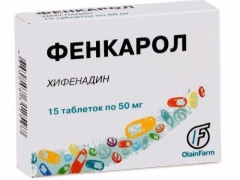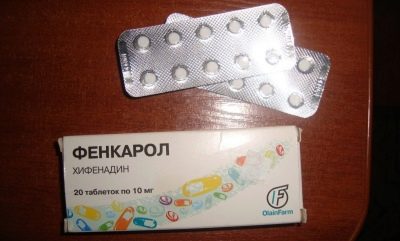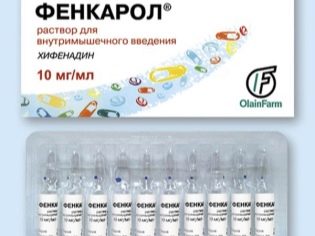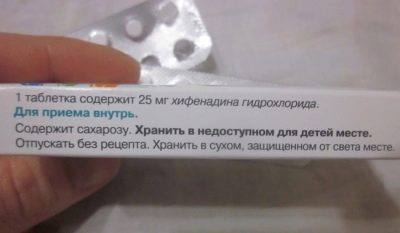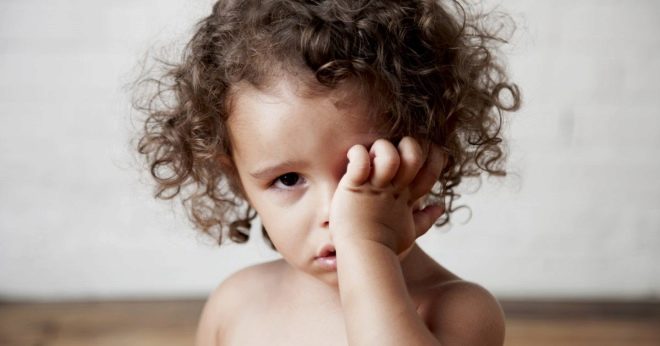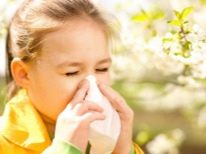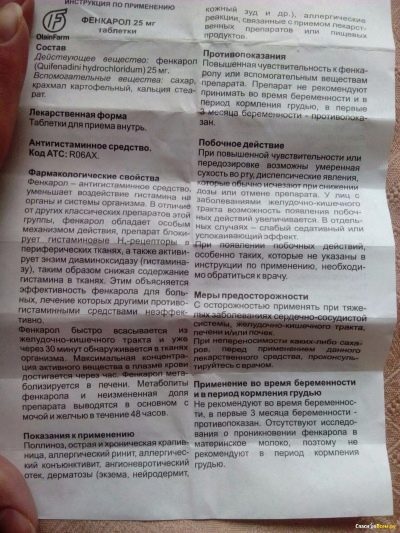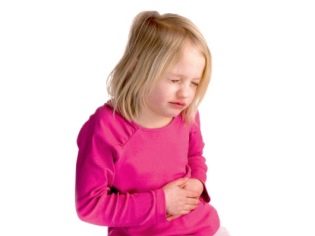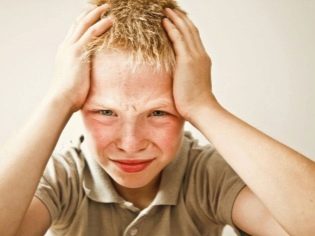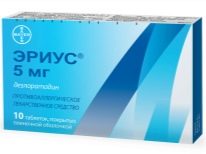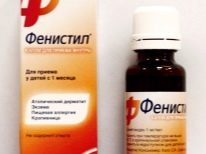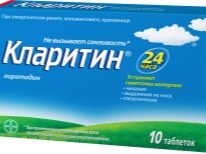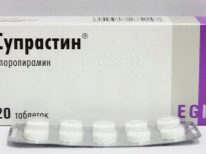Fenkarol for children: instructions for use
"Fenkarol" refers to antihistamines, so this drug is in demand in adults with urticaria, cough, skin rash, rhinitis, and other manifestations of allergy. It is possible to use this medicine in childhood, but with certain reservations - in particular, only the doctor prescribes a dose for young patients.
Release form
"Fenkarol" is a product of the Latvian company Olainfarm and presented in pharmacies in two forms.
- Pills Available in three different dosages and characterized by a flat round shape and white color. On the drug with the lowest dosage there is a risk. In one package can be 15, 20 or 30 tablets.
- Solution for intramuscular injections placed in ampoules of 1 or 2 ml, and in one box are 10 ampoules. The solution itself is colorless and transparent. In the treatment of children under 18 years old this form of "Fenkarol" is not used.
Composition
The main ingredient "Fenkarol" called hifenadinom and is contained in a solid preparation in the form of hydrochloride. Its dosage per tablet is 10 mg, 25 mg or 50 mg. Additionally, the solid form of "Fenkarol" is sucrose, potato starch and calcium stearate. These substances provide tablets with density and other physical characteristics.
Operating principle
Hifenadine contained in the drug is able to block histamine receptors, due to which “Fencarol” facilitates the course of allergy or prevents its development. The medicine has an antipruritic effect. In addition, the drug reduces the permeability of blood vessels (this is due to its anti-edema effect), and also prevents the spastic effect of histamine on the bronchi and smooth muscles of the intestine.
The active substance "Fenkarol" is absorbed quite quickly and after 60 minutes after taking it, the level in the blood becomes maximum. Metabolic changes of this compound take place in the liver, and the drug is excreted within two days after administration, mainly with bile and urine. The inhibitory effect of the drug is usually absent and is found only in the case of individual hypersensitivity.
Indications
"Fenkarol" is in demand for various diseases of an allergic nature. This tool is prescribed for:
- allergic rhinitis;
- atopic dermatitis, eczema and other dermatoses;
- hives;
- pruritus due to medication or exposure to other allergens;
- neurodermatitis;
- pollinosis;
- Quincke edema.
From what age is prescribed?
Fenkarol tablet form is not used in the treatment of children under 3 years of age. If it is necessary to prescribe an antiallergic agent to the child of the first years of life, the use of “Fencarol” should be abandoned and the analogue allowed for young patients should be selected. If the patient is 3 years old, it is acceptable for him to give only pills that contain 10 or 25 mg of hifenadine.
The drug with the content of the active substance in a dose of 50 mg for children is not prescribed, because the dosage of such tablets for children is too high, and there is no possibility to divide the drug into halves (there is no risk).
Contraindications
"Fenkarol" can not be used for hypersensitivity to any of the components of the drug. Since tablets have sucrose, they are not used for hereditary diseases in which carbohydrate absorption is impaired. For children with kidney, digestive, cardiovascular, and liver diseases, medicine is given with caution.
Side effects
Taking Fencarol may cause a feeling of dry mouth and various dyspeptic symptoms. Such negative symptoms, as a rule, disappear if the dosage of tablets is reduced, but sometimes it is necessary to refuse further treatment, having picked up an analogue. In rare cases, the drug has a weak sedative effect.
Instructions for use
The medicine is given to the child after a meal in a dosage that the doctor selects based on the severity of the allergy and the patient's sensitivity to therapy.
- Children 3-7 years give tablets containing 10 mg of active ingredient. In such a single dosage, “Fencarol” is taken twice a day. Sometimes the doctor advises giving the child medicine 5 mg (half a 10 mg tablet). The maximum daily dose for children under seven years old is 20 mg of hifenadine.
- 7-12 years old child 10–15 mg is recommended for one dose, therefore one or one and a half tablets of 10 mg is given to such a patient. The frequency of taking the medicine at that age can be twice and thrice a day. At the same time a child should not receive more than 50 mg of active substance per day.
- Single dose to children over 12 years old is 25 mg of hifenadine. Most often, the drug is taken twice a day, but sometimes the doctor sees the need for a threefold intake. The maximum permissible dose per day is 100 mg.
The duration of treatment with Fencarol is determined individually, but most often the course of taking such a drug lasts from 10 to 15 days.
Overdose
If a child accidentally took “Fencarol” in an overdose, this will lead to dry mouth, headache, vomiting and other negative symptoms.
To eliminate them, it is recommended to wash the stomach and drink activated charcoal, and then show the patient to the doctor.
Interaction with other drugs
Since one of the actions of Hifenadine is to reduce the motility of the gastrointestinal tract, medication may affect the rate of absorption of drugs that are slowly absorbed in the intestine (for example, anticoagulants).
Terms of sale
A prescription is not required for the purchase of Fencarol tablets, but a specialist's examination is recommended. The average price of 20 tablets of 10 mg is 270-280 rubles.
Storage
Keep the pills at home in a dry place in which they will not reach the small children. The temperature during storage of the drug should not exceed +25 degrees. The shelf life of tablets with a dosage of 10 mg and 25 mg is 5 years.
Reviews
Most of the feedback left by parents about Fenkarol is positive. In them, the drug is called an affordable and effective antiallergic agent. According to moms, pills are easy to swallow (they have a small size), they do not cause drowsiness, but the symptoms of allergy are eliminated rather quickly. However, in some cases, the effect of treatment with Fencarol is weak, and sometimes the child has an adverse reaction to such medication, which causes a few, but negative reviews.
Analogs
Other drugs based on Hifenadine are not available, but if necessary, replace “Fencarol” with another drug, the doctor may prescribe an antihistamine with another active substance - The list of such alternatives is impressive.
- "Erius". The action of this drug provides desloratadine. For children, it is usually prescribed in syrup, since it is allowed from 1 year. Tablets in the shell prescribed from 12 years. Analogues of such drugs are “Blogir-3”, “Desloratadine”, “Ezlor”, “Elisey” and “Lordaestin”.
- "Fenistil". Such a drug acts through dimetindenu and comes in several forms.Drops and gel are used even in infants, as they are allowed from 1 month.
- «Claritin». This medicine contains loratadine and is available in syrup (it can be given to children from two years old) and tablets (they are discharged from the age of 3). Instead of "Claritin" can be assigned such analogues as "Claricens", "Lomilan", "Loratadine Shtada and others.
- "Parlazin". Such a drug based on cetirizine in drops is used in children older than a year, and in tablet form - from 6 years. It can be replaced by other drugs containing cetirizine, for example, Zodak, Allertek, Zyrtec orTsetrin».
- "Suprastin". This drug acts due to chloropyramine and is available in tablets as well as in injectable form. In children, it is used from 1 month.
- «Erespal». The basis of this drug is fenspirid. Especially for children it is produced in a syrup that can be given to patients older than two years.
All about the causes, types and ways to combat allergies, see the next video.
